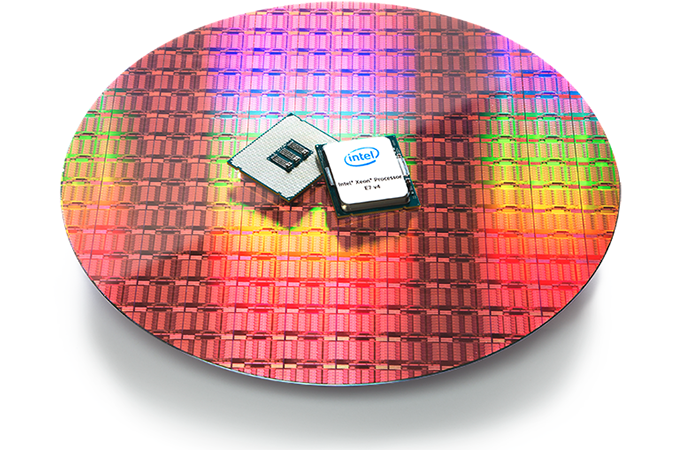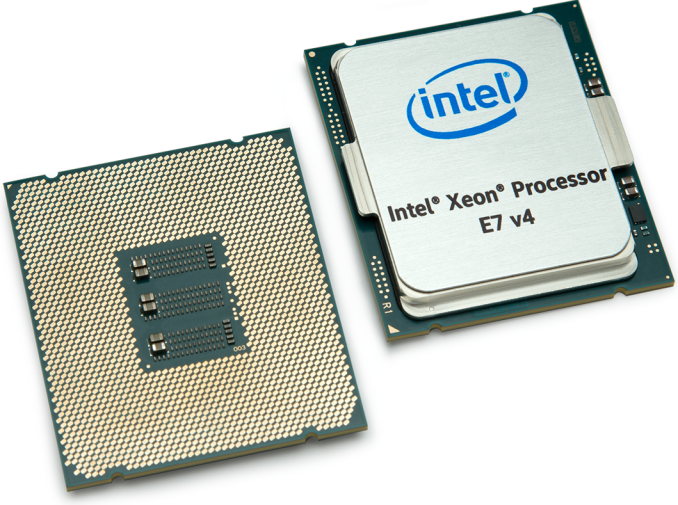Intel Announces the Xeon E7-8894 v4 CPU: 24 Cores at 2.4 GHz for $8898
by Anton Shilov on February 13, 2017 9:00 AM EST- Posted in
- CPUs
- Intel
- Xeon
- Servers
- Broadwell-EX
- E7-8894 v4

In the past week, Intel has launched a new halo CPU - its highest-performing multi-core CPU for multi-socket mission-critical servers, the Xeon E7-8894 v4. The new processor is based on the Broadwell-EX die and has approximately a 200 MHz higher base frequency than its direct predecessor, released in Q2 2016. Intel said that the new CPU has set a number of records in various benchmarks. Intel’s customers interested in the chip will also have to pay a record price too.
The flagship Intel Xeon E7-8894 v4 processor features the Broadwell-EX XCC (extreme core-count) die and has 24 cores with Hyper-Threading technology, 60 MB of L3 cache, 165 W TDP, a default frequency of 2.4 GHz and a turbo frequency of up to 3.4 GHz. Like other Broadwell-EX XCC CPUs, the new chip has quad-channel DDR3/DDR4 memory controller support and can manage up to ~3 TB of DRAM per socket (when used in conjunction with four Jordan Creek 2 scalable memory buffers). The CPUs are also equipped with 32 PCIe 3.0 lanes and three 9.6 GT/s QPI links for multi-socket environments.
| Intel E7-8800 v4 Xeon Family | ||||||||
| E7-8867 v4 | E7-8870 v4 | E7-8880 v4 | E7-8890 v4 | E7-8894 v4 |
E7-8891 v4 | E7-8893 v4 | ||
| TDP | 165 W | 140 W | 150 W | 165 W | 165 W | 140 W | ||
| Cores | 18 / 36 | 20 / 40 | 22 / 44 | 24 / 48 | 10 / 20 | 4 / 8 | ||
| Base Freq | 2400 | 2100 | 2200 | 2200 | 2400 | 2800 | 3200 | |
| Turbo | 3300 | 3000 | 3300 | 3400 | 3500 | 3500 | ||
| L3 Cache | 45 MB | 50 MB | 55 MB | 60 MB | 60 MB | 60 MB | ||
| QPI (GT/s) | 3 × 9.6 | 3 x 9.6 | 3 x 9.6 | |||||
| DRAM | DDR4-1866 DDR3-1600 |
DDR4-1866 DDR3-1600 |
||||||
| PCIe | PCIe 3.0 x32 | 3.0 x32 | 3.0 x32 | |||||
| Price | $4672 | $4762 | $5895 | $7174 | $8898 | $6841 | $6841 | |
Intel’s multi-core Xeon E7 processors are designed for various heavy-duty servers with four, eight or more sockets (to support more than eight sockets special third-party node controllers are required). Such mission-critical machines typically to be available 24/7/365 and this is why the Xeon E7 v4 and the Broadwell-EX range has a host of various RAS (reliability, availability, serviceability) features. The Xeon E7-8894 v4 CPU has exactly the same set of capabilities as its direct predecessor, the Xeon E7-8890 v4 released last year.
Intel claims that due to increased default frequency (and obviously because of the core count in general), the Xeon E7-8894 v4 sets a number of performance records in various general, server, HPC, big data analytics, business processing, database and other benchmarks, such as SPECint_base2006, SPECompG_2012, and so on.
The Intel Xeon E7-8894 v4 processor carries a tray price of $8898, which is the highest price of an Intel mass-produced CPU ever. Its predecessor on the top spot in the range, the 24-core Xeon E7-8890 v4 (which runs at 2.2 GHz) is priced at $7174 and still sits at its original tray price. As always, there are customers willing to pay such sums of money for server CPUs that deliver certain levels of performance. Moreover, there are workloads that benefit from a +200MHz (9%) performance increase so significantly (from a financial point of view to the owners of the machines) that it justifies paying extra 24% (or $1724) for a 200 MHz frequency increase (provided that this is the only advantage that this CPU has over the E7-8890 v4).
| Intel Xeon E-Series Families (February 2017)* | |||||
| E3-1200 v5 | E3-1500 v5 | E5-1600 v4 E5-2600 v4 E5-4600 v4 |
E7-4800 v4 | E7-8800 v4 | |
| Core Family | Skylake | Skylake | Broadwell | Broadwell | Broadwell |
| Core Count | 2 to 4 | 2 to 4 | 4 to 22 | 8 to 16 | 4 to 24 |
| Integrated Graphics | Few, HD 520 | Yes, Iris Pro | No | No | No |
| DRAM Channels | 2 | 2 | 4 | 4 | 4 |
| Max DRAM Support (per CPU) | 64 GB | 64 GB | 1536 GB | 3072 GB | 3072GB |
| DMI/QPI | DMI 3.0 | DMI 3.0 | 2600: 1xQPI 4600: 1xQPI |
3 QPI | 3 QPI |
| Multi-Socket Support | No | No | 2600: 1S/2S 4600: 1S/2S |
1S, 2S or 4S | Up to 8S |
| PCIe Lanes | 16 | 16 | 40 | 32 | 32 |
| Cost | $213 to $612 |
$396 to $1207 |
$294 to $7007 |
$1223 to $3003 |
$4061 to $8898 |
| Suited For | Entry Workstations | QuickSync, Memory Compute |
High-End Workstation | Many-Core Server | World Domination |
*Intel also has the E3-1500M v5 and E3-1500M v6 mobile parts which are left out of this table
We've asked Intel to disclose the official per-core turbo numbers for comparison to their other chips, as well as a full range of DRAM support depending on memory type and memory density. We will update this news piece as we get more information.
Related Reading:
Source: Intel











83 Comments
View All Comments
fanofanand - Monday, February 20, 2017 - link
This 10000x over. There are no such things as a free lunch.nils_ - Tuesday, February 14, 2017 - link
I too wonder what the point of these chips is, only thing that makes this special is the insane amount of cache for a 4 core part, maybe there is some sort of application that needs this type of cache? Or Intel is just taking the piss hoping people order them by mistake ;)Samus - Tuesday, February 14, 2017 - link
I guess yields must be good. 60MB cache. Jesus. I remember when servers with 64MB of RAM were elite, now it's on die. LOL.nils_ - Tuesday, February 14, 2017 - link
yeah I 'member, and even the cache wasn't on die.Notmyusualid - Saturday, February 18, 2017 - link
Good point.LeptonX - Tuesday, February 14, 2017 - link
That 8K USD E7 CPU is actually useful when you want to maximize performance per core because of the software licensing costs that are per core and you need all the RAS features that other Intel CPUs don't have. So your outrage is just stupid. It all comes down to software licensing per core.As it also has a lot of cache so it can actually perform well compared to higher-clocked CPUs but based on quad core dice.
Topweasel - Wednesday, February 15, 2017 - link
People keep saying Price per core in Licensing. But I think everyone means Socket. But yeah with highend server software being 5k-10k per Socket. It's all about how many cores you can fit on a socket. Take a decent value CPU like E5-2620 V4 at ~$500. Sure $1500 for three of those seems like a better deal but not when the software you want to run (lets say a low end of 5k per socket). All of a sudden that 10k processor just made all of your money back and in smaller package. You start expanding on that needing 48 full cores, or 96. Still possible in a single machine vs. Having to get 3 or 4 boxes for 8c systems. Now the full server costs get to be added per 32c and you have the 9k CPU actually saving you money.nils_ - Wednesday, February 15, 2017 - link
Luckily I don't have to deal much with proprietary software, but I would say that most companies license per core, not per socket. I know that Oracle does.phoenix_rizzen - Wednesday, February 15, 2017 - link
Microsoft is switching to per-core licensing for some of their products as well.Topweasel - Thursday, February 16, 2017 - link
Well now because the core counts have started to increase. I know at my work Vsphere is by socket and host system. You still run into packaging issues. Need 400c worth of a server farm. That's 4 4s servers here. But at 8c per socket, that's 16 4s systems. That's one Rack worth servers versus 3.